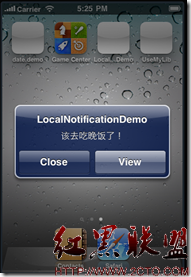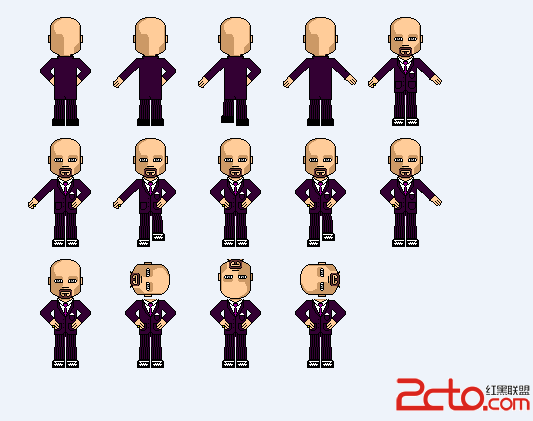iPhone开发之本地通知
本地通知,local notification,用于基于时间行为的通知,比如有关日历或者todo列表的小应用。另外,应用如果在后台执行,iOS允许它在受限的时间内运行,它也会发现本地通知有用。比如,一个应用,在后台运行,向应用的服务器端获取消息,当消息到达时,比如下载更新版本的提示消息,通过本地通知机制通知用户。
本地通知是UILocalNotification的实例,主要有三类属性:
scheduled time,时间周期,用来指定iOS系统发送通知的日期和时间;
notification type,通知类型,包括警告信息、动作按钮的标题、应用图标上的badge(数字标记)和播放的声音;
自定义数据,本地通知可以包含一个dictionary类型的本地数据。
对本地通知的数量限制,iOS最多允许最近本地通知数量是64个,超过限制的本地通知将被iOS忽略。
如果就写个简单的定时提醒,是很简单的,比如这样:

示例写的很简单,启动应用后,就发出一个定时通知,10秒后启动。这时按Home键退出,一会儿就会提示上图的提示信息。如果应用不退出则无效。
代码如下:
UILocalNotification *notification=[[UILocalNotification alloc] init];
if (notification!=nil) {
NSLog(@">> support local notification");
NSDate *now=[NSDate new];
notification.fireDate=[now addTimeInterval:10];
notification.timeZone=[NSTimeZone defaultTimeZone];
notification.alertBody=@"该去吃晚饭了!";
[[UIApplication sharedApplication] scheduleLocalNotification:notification];
更详细的代码见官方文档:《Sche易做图ng, Registering, and Handling Notifications》,可以设置比如声音,比如用户定义数据等。
设置更多本地通知的信息:
设置icon上数字。
- (BOOL)application:(UIApplication *)application didFinishLaunchingWithOptions:(NSDictionary *)launchOptions {
// Override point for customization after application launch.
/////////////
application.applicationIconBadgeNumber = 0;
// Add the view controller’s view to the window and display.
[self.window addSubview:viewController.view];
[self.window makeKeyAndVisible];
return YES;
}
添加通知时间,通知类型,取消通知
#pragma mark –
#pragma mark onChageValue
-(IBAction)onChangeValue:(id)sender
{
UISwitch *switch1=(UISwitch *)sender;
if (switch1.on) {
UILocalNotification *notification=[[UILocalNotification alloc] init];
NSDate *now1=[NSDate date];
notification.timeZone=[NSTimeZone defaultTimeZone];
notification.repeatInterval=NSDayCalendarUnit;
notification.applicationIconBadgeNumber = 1;
notification.alertAction = NSLocalizedString(@"显示", nil);
switch (switch1.tag) {
case 0:
{
notification.fireDate=[now1 dateByAddingTimeInterval:10];
notification.alertBody=self.myLable1.text;
}
break;
case 1:
{
notification.fireDate=[now1 dateByAddingTimeInterval:20];
notification.alertBody=self.myLable2.text;
}
break;
case 2:
{
notification.fireDate=[now1 dateByAddingTimeInterval:30];
notification.alertBody=self.myLable3.text;
}
break;
default:
break;
}
[notification setSoundName:UILocalNotificationDefaultSoundName];
NSDictionary *dict = [NSDictionary dictionaryWithObjectsAndKeys:
[NSString stringWithFormat:@"%d",switch1.tag], @"key1", nil];
[notification setUserInfo:dict];
[[UIApplication sharedApplication] scheduleLocalNotification:notification];
}else {
NSArray *myArray=[[UIApplication sharedApplication] scheduledLocalNotifications];
for (int i=0; i<[myArray count]; i++) {
UILocalNotification *myUILocalNotification=[myArray objectAtIndex:i];
if ([[[myUILocalNotification userInfo] objectForKey:@"key1"] intValue]==switch1.tag) {
[[UIApplication sharedApplication] cancelLocalNotification:myUILocalNotification];
}
}
}
}
摘自 Evolution
补充:移动开发 , IOS ,




